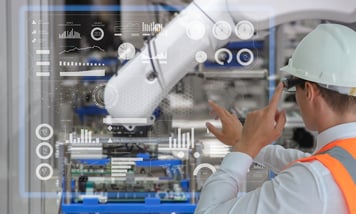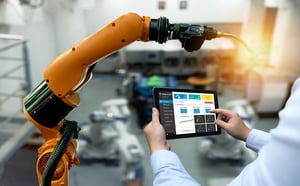Robots-as-a-Service uses a cloud-based system which allows for easier requirement changes.
 The intent behind these “as-a-service” implementations is to democratize the technology while lowering the barrier to entry for businesses, large and small alike. The “as-a-service” philosophy is becoming more prevalent in today’s working environment and is spreading to new aspects of work. One of those new arenas is robotics as a service (RaaS).
The intent behind these “as-a-service” implementations is to democratize the technology while lowering the barrier to entry for businesses, large and small alike. The “as-a-service” philosophy is becoming more prevalent in today’s working environment and is spreading to new aspects of work. One of those new arenas is robotics as a service (RaaS).
RaaS takes the capabilities of robotics and removes the upfront cost of typically expensive automation upgrades. RaaS is a cloud-based “robotic rental” system that allows users to incorporate the capabilities they need when they need them, upgrade or downgrade systems as requirements change, and install robotics without requiring the necessary infrastructure required by more traditional robotics implementations. RaaS works by utilizing on-site robotic hardware with cloud-based programming and automation, allowing the users to supply power, train the robot, and begin using it. This capability allows users to rapidly spool up production, reduces the upfront installation costs, and adjust capabilities on the fly.
Typically, a robot installation requires large amounts of computing power, utilities, and knowledge, and that’s just to get it installed. The cloud-based robotic system removes a lot of the upfront requirements, as the computing power and knowledge are already established at the service provider, leaving just the requirements for the on-site hardware (physical installation and power). Having an established control system and control infrastructure greatly reduces the initial outlay to the user, as they don’t have to purchase those items in addition to the robot.
 Additionally, as requirements change, the system can be upgraded or downgraded as necessary. This prevents unnecessary robots from taking up much-needed resources like floor space, electrical power, and computing power. Instead of repurposing a now obsolete robot for a job it may or may not be suited for, a new robot that is matched to the job can be brought in and begin producing while the old robot is returned to the service provider.
Additionally, as requirements change, the system can be upgraded or downgraded as necessary. This prevents unnecessary robots from taking up much-needed resources like floor space, electrical power, and computing power. Instead of repurposing a now obsolete robot for a job it may or may not be suited for, a new robot that is matched to the job can be brought in and begin producing while the old robot is returned to the service provider.
Examples of RaaS include:
- Building security: Having robots patrol buildings can result in savings of up to 65% over traditional human guards. Further, the data the robots collect is fed back to artificial intelligence algorithms that can find insights to help make the security systems better.
- Warehouse operations: Warehouse operators are often stressed to find sufficient workers during seasonal surges in demand. With a RaaS system, those seasonal labor shortcomings can be mitigated without having to pay for a full-blown system that would otherwise not be needed during other times of the year.
Further examples of markets primed for RaaS implementations abound, as the reduction in resources makes these systems more easily available to companies. If you’re trying to figure out how to improve productivity or reduce risk but have always thought robots were out of your price range, RaaS might be the answer for you.
This article originally appeared on the Robotics Online Blog. Robotic Industries Association (RIA) is a part of the Association for Advancing Automation (A3), a CFE Media content partner.









